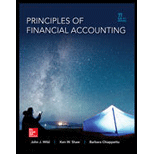
Concept explainers
Prepare a three-column comparative income statement for (1) Normal business without special order, (2) New business, and (3) combined business.
Explanation of Solution
Income statement: The financial statement which reports revenues and expenses from business operations and the result of those operations as net income or net loss for a particular time period is referred to as income statement.
Prepare a three-column comparative income statement for (1) Normal business without special order, (2) New business, and (3) combined business as follows:
| Company J | |||
| Comparative Income Statements | |||
| Particulars |
(1) Normal business (400,000 packages) (A) |
(2) New Business (50,000 packages) (B) |
(3) Combined |
| Sales | $2,400,000 | $260,000 (W.N.6) | $2,660,000 |
| Less: Costs and expenses | |||
| Direct materials | 576,000 |
72,000 (W.N.7) | 648,000 |
| Direct labor | 144,000 |
27,000 (W.N.8) | 171,000 |
| 320,000 |
30,000 (W.N.9) | 350,000 | |
| Selling expenses | 150,000 | - | 150,000 |
| Administrative expenses | 100,000 | 5,000 | 105,000 |
| Operating income | $1,110,000 | $126,000 | $1,236,000 |
Table (1)
Working note 1:
Calculate the direct material cost per package for new business.
Working note 2:
Calculate the variable direct labor cost per package for new business.
Working note 3:
Calculate total direct labor cost per package for new business.
Working note 4:
Calculate the fixed overhead at any production level from 350,000 to 500,000 units for new business.
Working note 5:
Calculate the variable overhead per package for new business.
Working note 6:
Calculate the value of sales for new business.
Working note 7:
Calculate the direct material cost for new business.
Working note 8:
Calculate the direct labor cost for new business.
Working note 9:
Calculate the variable overhead for new business.
Want to see more full solutions like this?
- Please provide the correct answer to this general accounting problem using accurate calculations.arrow_forwardCan you solve this general accounting question with accurate accounting calculations?arrow_forwardCan you help me solve this general accounting question using valid accounting techniques?arrow_forward
- Can you help me solve this general accounting problem with the correct methodology?arrow_forwardI need assistance with this general accounting question using appropriate principles.arrow_forward(1) prepare the december 31 entry for bramble corporation to record amortization of intangibles. the trademark has an estimated useful life of 4 years with a residual value of $3,520arrow_forward

 AccountingAccountingISBN:9781337272094Author:WARREN, Carl S., Reeve, James M., Duchac, Jonathan E.Publisher:Cengage Learning,
AccountingAccountingISBN:9781337272094Author:WARREN, Carl S., Reeve, James M., Duchac, Jonathan E.Publisher:Cengage Learning, Accounting Information SystemsAccountingISBN:9781337619202Author:Hall, James A.Publisher:Cengage Learning,
Accounting Information SystemsAccountingISBN:9781337619202Author:Hall, James A.Publisher:Cengage Learning, Horngren's Cost Accounting: A Managerial Emphasis...AccountingISBN:9780134475585Author:Srikant M. Datar, Madhav V. RajanPublisher:PEARSON
Horngren's Cost Accounting: A Managerial Emphasis...AccountingISBN:9780134475585Author:Srikant M. Datar, Madhav V. RajanPublisher:PEARSON Intermediate AccountingAccountingISBN:9781259722660Author:J. David Spiceland, Mark W. Nelson, Wayne M ThomasPublisher:McGraw-Hill Education
Intermediate AccountingAccountingISBN:9781259722660Author:J. David Spiceland, Mark W. Nelson, Wayne M ThomasPublisher:McGraw-Hill Education Financial and Managerial AccountingAccountingISBN:9781259726705Author:John J Wild, Ken W. Shaw, Barbara Chiappetta Fundamental Accounting PrinciplesPublisher:McGraw-Hill Education
Financial and Managerial AccountingAccountingISBN:9781259726705Author:John J Wild, Ken W. Shaw, Barbara Chiappetta Fundamental Accounting PrinciplesPublisher:McGraw-Hill Education





